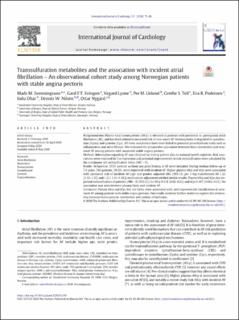Transsulfuration metabolites and the association with incident atrial fibrillation – An observational cohort study among Norwegian patients with stable angina pectoris
Svenningsson, Mads Malm; Svingen, Gard Frodahl Tveitevåg; Lysne, Vegard; Ueland, Per Magne; Tell, Grethe S.; Pedersen, Eva Ringdal; Dhar, Indu; Nilsen, Dennis W.T.; Nygård, Ottar
Journal article, Peer reviewed
Published version

Åpne
Permanent lenke
https://hdl.handle.net/11250/2755905Utgivelsesdato
2020Metadata
Vis full innførselSamlinger
- Department of Clinical Science [2396]
- Registrations from Cristin [10412]
Originalversjon
International Journal of Cardiology. 2020, 317, 75-80 https://doi.org/10.1016/j.ijcard.2020.05.010Sammendrag
Background/aim
Plasma total homocysteine (tHcy) is elevated in patients with persistent vs. paroxysmal atrial fibrillation (AF), and has been related to increased risk of new-onset AF. Homocysteine is degraded to cystathionine (Cysta) and cysteine (Cys). All three metabolites have been linked to potential proarrhythmic traits such as inflammation and atrial fibrosis. We evaluated the prospective association between these metabolites and new-onset AF among patients with suspected stable angina pectoris.
Methods
Information regarding AF was obtained by linking patient data to national health registries. Risk associations were explored by Cox regression and potential improvements in risk reclassification were calculated by the continuous net reclassification index (NRI > 0).
Results
At baseline, 3535 patients without any prior history of AF were included. During median follow-up of 7.4 years, 392 patients (10.2%) were registered with incident AF. Higher plasma tHcy and tCys were associated with increased risk of incident AF [age and gender adjusted HRs (95% CI) per 1 log transformed SD 1.23 (1.12–1.35) and 1.23 (1.11–1.38)]; multivariate adjustment yielded similar results. Plasma tHcy and tCys also improved reclassification of patients (NRI > 0 (95% CI)) for tHcy 0.118 (0.02–0.22) and tCys 0.107 (0.002–0.21). No association was seen between plasma Cysta and incident AF.
Conclusion
Plasma tHcy and tCys, but not Cysta, were associated with, and improved risk classification of, new-onset AF among patients with stable angina pectoris. Our results motivate further studies to explore the relationship between homocysteine metabolism and cardiac arrhythmias.
